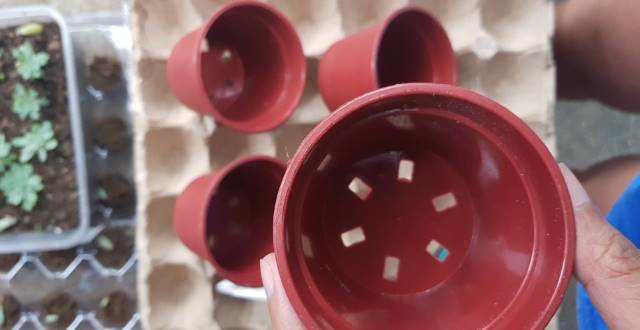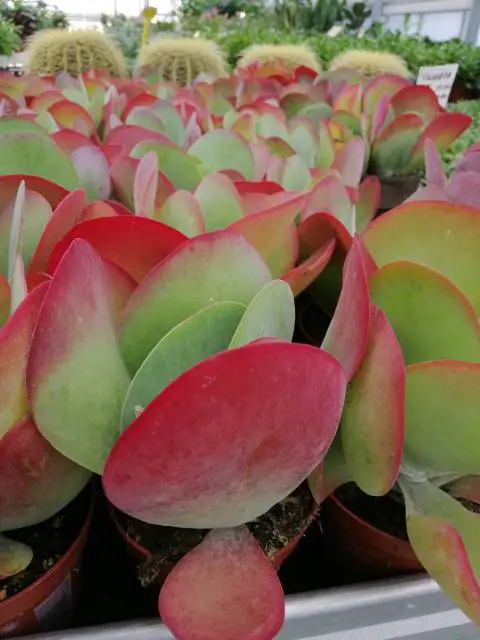Kalanchoe delagoensis famously known as Mother of Millions is a rapidly growing plant that multiplies easily wherever it falls. It is rightly given the name ‘Mother of millions’ due to its rapid multiplying ability. This succulent produces several tiny plantlets that appear at the ends of the leaves. These plantlets can take root relentlessly wherever they fall.
‘Mother of Millions is an aggressively growing invasive Kalanchoe succulent’
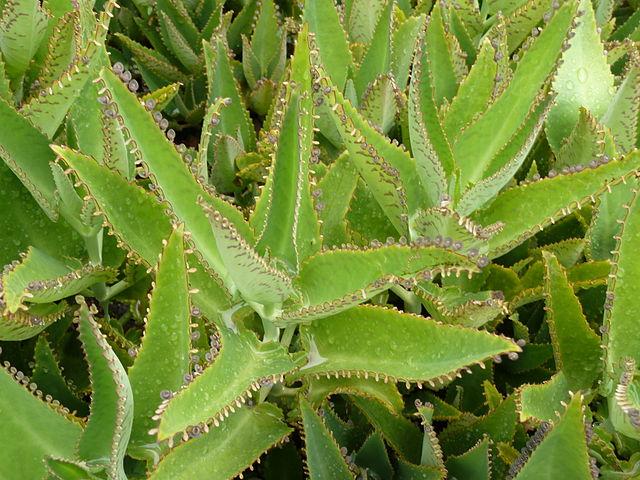
The rapidly growing ability of this succulent may sound interesting to you if you want to multiply the succulent, but keep in mind this succulent can take over your garden in no time. This succulent spreads by producing seeds and plantlets. It can be pulled out of the soil to check its growth, but the seeds remain viable in the soil for several years even when the plant is pulled out.
That is why the Mother of Millions is also considered as a weed (an unwanted plant) or an invasive species in some regions of the world. The same attribute that makes it unpleasant to some people, makes it highly desirable to several other people. It is an attractive succulent that is super easy to care for and multiplies enormously.
Is Mother of millions harmful to other plants?
Mother of Millions is an invasive succulent. They need to be kept away from other plants because they can take over an area in no time and hinder the growth of other plants in the surroundings. Some people find them really irritating and want to get rid of them, but these succulents are so difficult to eradicate completely. This succulent is easy to pull off, but the seeds remain viable in the soil for years that makes it so hard to get rid of them.
Common Name: Kalanchoe delagoensis is also known as Mother of millions, Chandelier Plant, Devil’s Backbone.
Synonym: Bryophyllum tubiflorum, Geaya purpurea, Kalanchoe tubiflora, Kalanchoe verticillata, Bryophyllum delagoense, Bryophyllum tubiflorum.
Origin and Habitat
Kalanchoe delagoensis is native to Madagascar (the world’s second-largest island country). Its habitat is the Rocky Mountains and dry soils of Madagascar.
What are the general features of Mother of Millions?
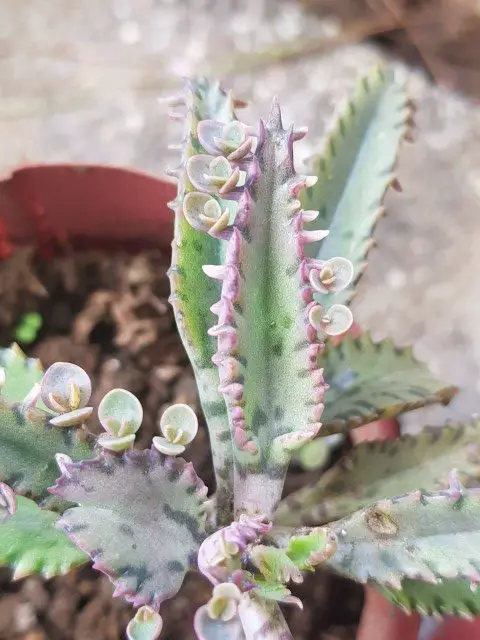
Kalanchoe delagoensis reproduces asexually by producing several tiny plantlets along the margins of the leaves. The succulent has an erect up to 3.3 feet (1 m) tall stem, often with short shoots at the base. The leaves are sub-cylindrical, simple, 6 inches long, and 0.2 inches wide. The leaves are often spotted with a reddish-brown color. The margins of the leaves near the apex have 3 to 9 conical teeth. Spoon shaped bulbils are produced between the conical teeth. The succulent produces orange to scarlet, trumpet-shaped flowers dangling in clusters from the top of the stem.
What is the difference between Mother of millions and Mother of Thousands?
There are several differences between Mother of Millions and Mother of Thousands. The biggest difference is in the shape of leaves.
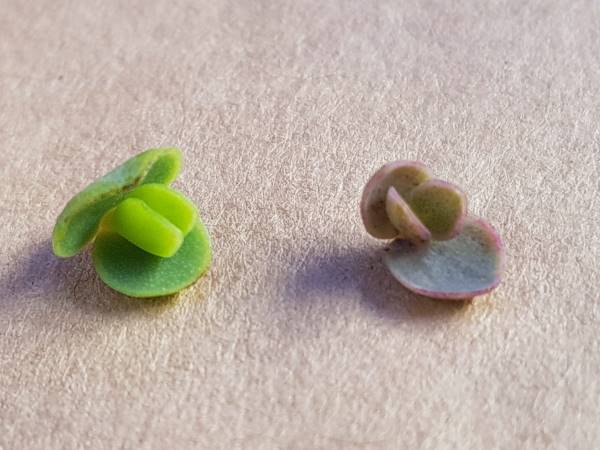
Mother of Millions
The mother of millions has very narrow leaves. Generally, 4 leaves arise at the same spot on the stem called the node. The leaves don’t appear in an alternate position like Mother of Thousands. The plantlets appear only at the end of the leaf near the tip. Mother of millions is recognized as a noxious invasive weed in parts of Africa and Australia due to its rapid and spreading growth habit.
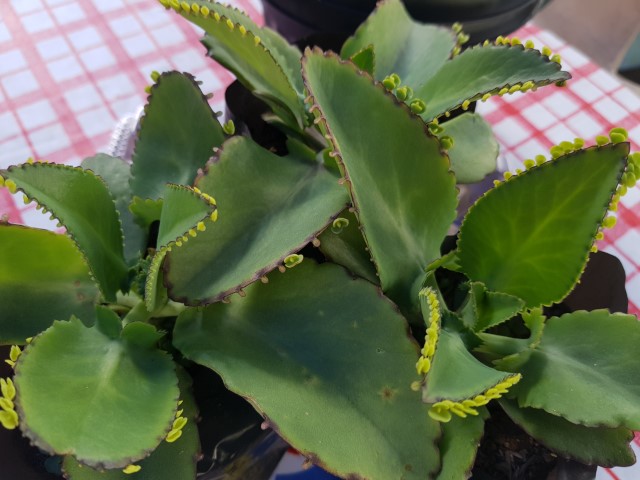
Another difference between the mother of millions and the mother of thousands is in their growth behavior. The mother of millions gives rise to several stalks arising from the sample plant and primarily grows in the upward direction. It can form bush like patches. However, Mother of Thousands has a central stalk that grows in the direction of sunlight. It often falls over due to the weight of leaves but continues growing.
Mother of Thousands
Mother of thousands has tear-shaped broad leaves. The leaves appear in pairs facing opposite to each other on the stem. The next pair of leaves rotate at 90 degrees angle. This arrangement allows the sunlight to reach each leaf equally and ensures that all the leaves get enough exposure to sunlight.
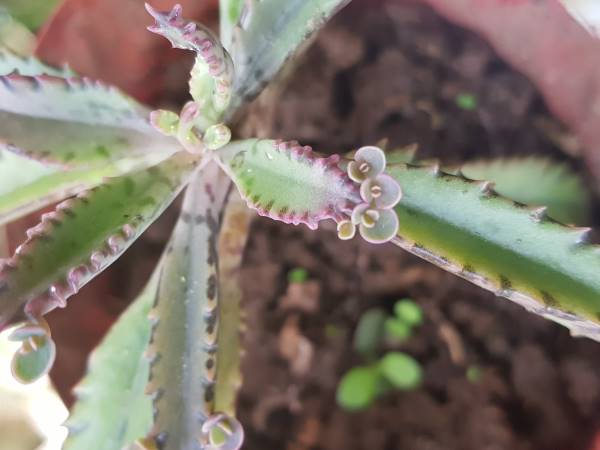
The margins of the leaves have little ridges. That is the place where the baby plantlets arise. These plantlets appear all along the margins of the leaves. Leaves also give rise to baby plants when they are damaged and about to die.
Is Mother of Millions an outdoor or indoor succulent?
The Mother of Millions can be grown both indoors and outdoor conditions. But you have to be very alert while growing Mother of millions in the garden. It grows so rapidly and takes over your garden in no time. Avoid the falling of tiny plantlets on the garden soil because they will start rooting in no time.
How to care for the Mother of Millions?
The Mother of millions is not only a drought-smart succulent, but it is highly adaptable to diverse environments. It is super easy to care for and grows well with minimal care.
Light requirements
Like all other Kalanchoe succulents, Mother of Millions prefers to grow under bright sunny locations. Outdoor succulents can be planted in full bright sun to partial shade.
Where should I keep Mother of Millions?
In areas where the summer season is extremely hot, and the sunlight is too intense they should be planted in partial shade.
Put the indoor Kalanchoe succulents near a bright sunny window for ample sunlight exposure. During the winter season keep your succulents near a south-facing window, while in the summer season move them near east or west-facing windows. Avoid direct contact with the windows during the summer season, when the sun is too intense it may cause the burning or scorching of the leaves.
Potting soil
Mother of Millions requires well-draining potting soil. You can use a special cactus soil mix or a succulent soil mix readily available in the market or you can prepare a potting mix on your own by mixing 40 to 50% grit (perlite and sand) with peat moss.
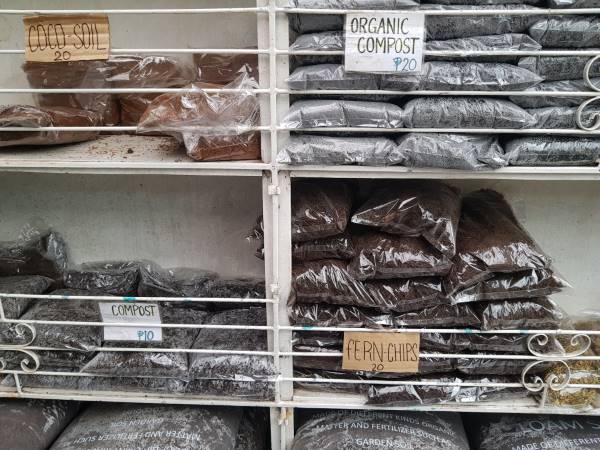
Coarse sand and perlite improve the drainage and aeration of the potting medium by increasing the soil porosity. A well-draining potting soil prevents the water build-up and saves the root from rotting and decay.
What type of potting medium should be avoided?
Avoid the use of a potting medium that is too clayey. The clayey soil will not have enough porosity to let the excess water drain out and it will ultimately lead to water build up in the potting soil, causing root rot and decay.
Which containers are recommended to grow Mother of Millions?
Pick the pots or containers with drainage holes to allow the excess water to drain out. It is recommended to use terracotta pots or glazed ceramics because they have good drainage capacity and provide exceptional results.
Temperature requirements
Mother of Millions needs warm temperatures to thrive well. It cannot survive freezing temperatures. It grows well at a temperature range of 30 to 50 degrees Fahrenheit. If the temperature drops below freezing it will cause frost injury and death in no time.
How to save the succulents from frost injury?
If there is a risk of frost it is better to bring the potted plants indoors and place in a sunny windowsill or under artificial grow lights. If the succulents are grown in the garden soil it is better to cover them with frost clothes to protect from the damage caused by freezing temperatures. It has been reported that even a few hours of exposure to below freezing temperatures is enough to kill the Kalanchoe succulents.
Water requirements
Mother of Millions is a drought-tolerant succulent, and it can tolerate a considerable period of neglect. The watering needs vary with the seasonal temperatures. Mother of Millions needs moderate irrigation in the autumn and spring seasons, while during summer they need to be irrigated more often. In the summer season, the evaporation rate is very high due to the hot weather, and the water is lost at a rapid rate from the soil. During the winter season, the succulents need occasional watering, therefore, irrigate only if the plants start shriveling.
Water well and let it drain out of the drainage holes. Then wait for the soil to dry out completely before applying the next irrigation. Insert your finger in the soil if the top 1 to 2 inches feel dry, it is the right time to water.
Note: Overwatering is the most commonly occurring problem causing the death of the succulents. Excess of water causes rotting and decay of the roots; it also encourages fungal growth.
Can I use spray bottles to water the Mother of Millions?
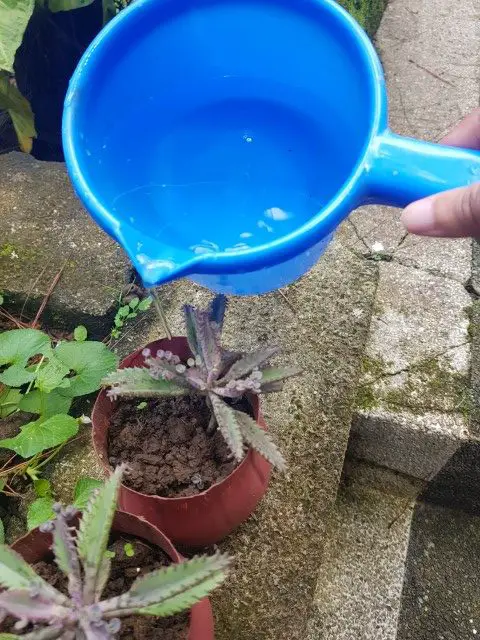
Avoid using spray bottles. The most common watering mistake is that you water your Kalanchoe succulents by spraying water on the leaves. This method only works for propagating new Kalanchoe succulents. In mature plants, it is the root system that absorbs water and nutrition for the succulent. Water the soil directly near the root zone using water bottles or cans for better water utilization efficiency.
Another disadvantage of using spray bottles is that the water stays on the leaves and can cause rotting.
What is the right time to water Mother of Millions?
The best time to water is in the morning. Avoid watering your Kalanchoe succulents at noon or in the afternoon. Also do not water your succulents when the weather is too humid or extremely hot.
Does Mother of Millions like humidity?
All varieties of Kalanchoe succulents can generally take all levels of humidity. The only thing that varies with the humidity is their watering needs. If the humidity is very high, the succulents need less water, while at low humidity they may need water more often.
Though humidity does not impact the overall plant growth directly, however, high humidity can likely encourage the fungal growth on the succulents. Generally, the humidity at room temperature is fine for the growth of the Mother of Millions.
Does Mother of Millions need to be fertilized?
Though Mother of Millions gets plenty of nutrition from the potting medium, it can be benefited from a moderate dose of some extra nutrients.
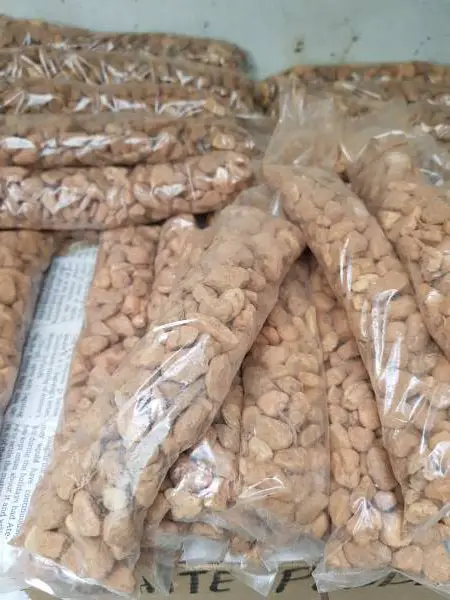
It is recommended to fertilize your succulents during the active growing phase biweekly or monthly with a light dose of manufacturer’s recommended 20:8:20 cactus fertilizer or a succulent fertilizer mix. Avoid feeding your succulents when they are in the dormant phase.
Can I use coffee grounds, eggshells, and banana peels to fertilize Mother of Millions?
As the coffee grounds easily break down in the soil, they will add nitrogen to the potting medium. Nitrogen is a vital nutrient for Kalanchoe succulents because it is a major component of chlorophyll. Coffee grounds will also help to improve soil aeration and drainage. Coffee grounds may even suppress pests and weeds.
Eggshells can be used in succulent gardens. You can use the eggshell tea to give an added dose of calcium to the Kalanchoe succulents. Eggshells will also give them an extra dose of potassium.
Banana peels are good for Kalanchoe succulents. They contain essential minerals that are beneficial for your succulents. They are not only a rich source of potassium and phosphorus, but they also contain some other elements like calcium, sodium manganese, and sulfur.
How to propagate Mother of Millions?
Mother of Millions can be propagated by using the miniature plantlets and leaf cuttings. This method is unique to this plant.
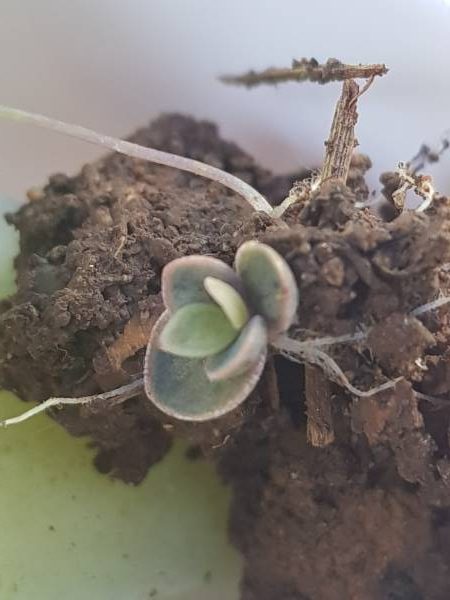
To propagate new succulents just take the small plantlets from the margins of the leaves or the leaf cuttings. Set aside the plantlets or cuttings at a warm dry place for 2 to 3 days to develop callous.
Fill the containers (in which you wish to propagate the succulents) with a standard succulent mix. Place the plantlets or cuttings at the top of the pre-moistened potting soil (a mix of sand, perlite, and peat moss). Keep misting the plantlets or cuttings regularly 5 to 6 times a day and keep the soil evenly moist. The cuttings need more water until they establish in the soil. But do not overwater it will rot the cuttings in no time.

Keep the containers near a window with indirect sunlight. Avoid exposure to bright direct sunlight until the succulents are established in the soil. The succulents will start rooting after 2 to 3 weeks and will be ready to transplant into new containers.
Can I propagate Mother of Millions by using seeds?
Yes, Mother of Millions can be propagated by using seeds. The seeds should be left to dry for some time before sowing. They should be preferably sown in the spring season. When the seedlings grow large enough to handle, they must be transplanted into new containers or garden beds. Keep in mind seed propagation is slightly different that requires patience and a bit of expertise to ensure success.
How often to repot Mother of Millions?
Mother of Millions does not require frequent repotting. It can thrive well in the same container for years. However, a general rule is to repot all Kalanchoe succulents every 2 years, it will provide a fertile potting medium to the succulents with plenty of nutrients. Even if your Kalanchoe has completed 2 years in the same pot and is growing healthy still it is recommended to transfer your Kalanchoe succulents into new containers.
It is also recommended to repot in certain other conditions, for example, when the potting medium and the containers have poor drainage, the succulent is infested by insect pests or diseases, and when the container is too small for the succulent to grow and spread. It is also advised to repot every time you buy a new succulent from the market.
Does Mother of Millions need pruning?
Mother of Millions is an invasive plant and grows at a rapid rate. If the tiny plantlets fall below and start rooting, they should be removed immediately.
The best way to prune Mother of Millions is to snip off the top portion of the succulent just above a leaf because it grows so rapidly and the new growth will appear in no time. With regular grooming, you can encourage healthy and thick growth.
It is also recommended to remove the spent blooms and dead leaves to encourage more blooming and healthier growth in the next growing season.
Is Mother of Millions poisonous?
Generally, all Kalanchoe succulents are toxic to pet animals, birds, and livestock. They must be kept out of the reach of toddlers because they can cause stomach upset.
Kalanchoe succulents contain cardiac glycosides that are toxic to pet animals. If you are keeping pets at home, it is advised to keep the succulents away from cats and dogs because if they ingest any plant part it can lead to serious consequences. The pets will start developing several symptoms after ingestion such as diarrhea, vomiting, change in heart rate and rhythm, stomach upset or pain, and excessive slobbering.
If you observe any of the above-mentioned symptoms of poisoning take your pet immediately to an expert Veterinarian.
What are the potential pests of Mother of Millions?
Mother of Millions is generally not prone to insect pests. Mealybugs and aphids can be occasionally observed attacking the indoor succulents. However, these insects are not a very big problem. You can control the infestation easily if you are lucky enough to spot the problem at an early stage. It can also be attacked by snails and slugs.
Why do the leaves of Mother of Millions turn yellow?

Overwatered Kalanchoe succulent is prone to rotting. If the soil has poor drainage the water accumulates in the soil and causes the disintegration of roots. It will ultimately stop the supply of water and nutrients to the plants resulting in several symptoms such as yellowing of leaves, wilting, and death of the succulent.
From where I can purchase Mother of Millions?
You can look for Mother of Millions in the nearby local nurseries or plant markets. You can also buy Mother of Millions from online shopping websites. I have also seen several Facebook pages of different plant nurseries that have made it easier to buy the Kalanchoe succulents online. Just look for the local shippers in your area and ask them for your favorite Kalanchoe succulents. You can easily order your favorite Kalanchoe succulents online and get them delivered at your doorstep.
Here are our affiliate links. It is same price as non affilate links, but purchase through our links would get us small provision, and would help us running this website.
I hope this care guide will help you solve all your gardening problems related to Mother of Millions. Do write to us if you have any questions or queries about this amazing succulent.
Happy Planting!

